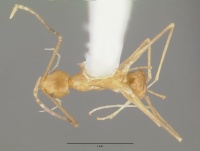Paraparatrechina pallida
| Paraparatrechina pallida | |
|---|---|

| |
| Paraparatrechina pallida | |
| Scientific classification | |
| Kingdom: | Animalia |
| Phylum: | Arthropoda |
| Class: | Insecta |
| Order: | Hymenoptera |
| Family: | Formicidae |
| Subfamily: | Formicinae |
| Tribe: | Lasiini |
| Genus: | Paraparatrechina |
| Species: | P. pallida |
| Binomial name | |
| Paraparatrechina pallida (Donisthorpe, 1947) | |
Identification
Distribution
Latitudinal Distribution Pattern
Latitudinal Range: -3.089444444° to -7.734722222°.
| North Temperate |
North Subtropical |
Tropical | South Subtropical |
South Temperate |
- Source: AntMaps
Distribution based on Regional Taxon Lists
Indo-Australian Region: New Guinea (type locality).
Distribution based on AntMaps
Distribution based on AntWeb specimens
Check data from AntWeb
Countries Occupied
| Number of countries occupied by this species based on AntWiki Regional Taxon Lists. In general, fewer countries occupied indicates a narrower range, while more countries indicates a more widespread species. |

|
Estimated Abundance
| Relative abundance based on number of AntMaps records per species (this species within the purple bar). Fewer records (to the left) indicates a less abundant/encountered species while more records (to the right) indicates more abundant/encountered species. |

|
Biology
Castes
Nomenclature
The following information is derived from Barry Bolton's Online Catalogue of the Ants of the World.
- pallida. Paratrechina (Paraparatrechina) pallida Donisthorpe, 1947d: 192, fig. 2 (w.) NEW GUINEA. Combination in Paraparatrechina: LaPolla, Brady & Shattuck, 2010a: 128.
Description
References
- Donisthorpe, H. 1947e. Some new ants from New Guinea. Ann. Mag. Nat. Hist. 11(14): 183-197. (page 192, fig. 2 worker described)
References based on Global Ant Biodiversity Informatics
- Donisthorpe H. 1947. Some new ants from New Guinea. Annals and Magazine of Natural History (11)14: 183-197.
- Janda M., G. D. Alpert, M. L. Borowiec, E. P. Economo, P. Klimes, E. Sarnat, and S. O. Shattuck. 2011. Cheklist of ants described and recorded from New Guinea and associated islands. Available on http://www.newguineants.org/. Accessed on 24th Feb. 2011.
- Janda M., and M. Konecna. 2011. Canopy assembalges of ants in a New Guinea rain forest. Journal of Tropical Ecology 27: 83-91.
- Klimes P., M. Janda, S. Ibalim, J. Kua, and V. Novotny. 2011. Experimental suppression of ants foraging on rainforest vegetation in New Guinea: testing methods for a whole-forest manipulation of insect communities. Ecological Entomology 36: 94-103.
- Klimes P., P. Fibich, C. Idigel, and M. Rimandai. 2015. Disentangling the diversity of arboreal ant communities in tropical forest trees. PLoS ONE 10(2): e0117853. doi:10.1371/journal.pone.0117853
- Snelling R. R. 1998. Insect Part 1: The social Hymenoptera. In Mack A. L. (Ed.) A Biological Assessment of the Lakekamu Basin, Papua New Guinea, RAP 9. 189 ppages
- Snelling R. R. 2000. Ants of the Wapoga river area, Irian Jaya, Indonesia. In Mack, Andrew L. and Leeanne E. Alonso (eds.). 2000. A Biological Assessment of the Wapoga River Area of Northwestern Irian Jaya, Indonesia. RAP Bulletin of Biological Assessment 14, Conservation International, Washington, DC.
- Wilson E. O. 1959. Some ecological characteristics of ants in New Guinea rain forests. Ecology 40: 437-447.

